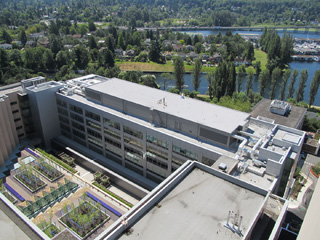|
Subscribe / Renew |
|
|
Contact Us |
|
| ► Subscribe to our Free Weekly Newsletter | |
| home | Welcome, sign in or click here to subscribe. | login |
Architecture & Engineering
| |
 |
July 26, 2012
Hospital’s mechanical design process a complex dance
Notkin Mechanical Engineers

Bellows
|

Lohr
|
The University of Washington Medical Center’s new tower will provide expanded space for critical functions and improved care and safety for patients.
When design began in 2007 the tower was intended to be a five-story mix of shell and core and fully developed space. It would span the loading dock and a significant cross-campus arterial.
The building process was expected resemble the cha-cha-cha: energetic with a steady beat and minimal disruption or breaks. As construction was under way, the university decided to build three additional floors.
So began a dance that was more like a quickstep: fast paced, involving a lot of patterned movement among the dancers.
Each of the eight floors connect with the existing hospital with minimal separation. Construction took place close to occupied patient-care areas. Strict attention to infection control and noise were critical to patient safety and comfort.
While there was nothing simple about constructing the original tower project so that it melded with the existing facility, this redirection required the design and construction team to work even closer with the university’s Capital Projects Office and medical center staff to ensure that daily hospital functions would continue and patient safety would not be compromised.
No surprises
Maintaining critical functions such as the pharmacy compounding lab or the bulk oxygen-supply system demanded surprise-free solutions. Each small improvement project required the dancers — members of the design and construction team — to choose partners that could coordinate and execute the work in an orderly, precise fashion without interrupting the dance.
The project required relocating the bulk oxygen-supply system, the music for the dance. The system serves the entire hospital and required multiple coordinated temporary feeds to maintain critical patient service.
When the building program changed to locate a bone marrow transplant unit on the eighth floor, the dance required a new step: a design-assist approach that allowed the team to virtually collaborate using 3-D CADD. Contractors and designers danced together to create a single building model that became construction documents and coordinated shop drawings.
Sophisticated facilities such as this medical center require complex mechanical systems to support diverse uses and constantly changing occupancies. Patient safety and infection control are of utmost importance, especially in hospital areas where the most fragile patients will be treated. Mechanical equipment and components are braced to allow staff and patients to continue occupying the facility after a seismic event without a significant impact to operations.
For infection-control purposes, patient-care areas will be served by 100 percent outside-air systems with enhanced filtering. Special attention was given to pressurization requirements, which call for sophisticated controls and room-by-room monitoring systems.
Modifications and additions to mechanical systems, such as the new chilled-water plant, will serve functions in the new tower and provide redundancy for systems in the primary facility.
High-efficiency systems
Neighborhoods surrounding the medical center are also impacted by this new facility.
The university recognizes the disruption a significant construction project can produce. It took particular care to mitigate noise generated by mechanical equipment and dedicated mechanical space below grade and on the tower’s third level. Provisions for future equipment replacement had to be thought out and included in the tower’s design.
Energy efficiency of the mechanical systems was important to the university, both as a matter of environmental responsibility to the community and the impact on operations cost and maintenance.
This high-performance medical center project’s annual energy savings of more than 2 billion British thermal units is equivalent to the amount of electricity used by 60 average Americans each year. The projected Energy Use Index (or EUI, the measurement of energy use in thousands of BTUs per square foot of gross floor area) is 150, compared with a code-level hospital in Seattle of 245.
This efficiency will be achieved through a high-performance envelope (exterior sunshades and high performance glass and fritting), recovering building heat via heat-recovery chillers, variable-flow chillers and premium efficiency motors. Seattle City Light recognized the significance of this efficiency by awarding a $128,000 rebate to the hospital.
This project is a step forward for the construction industry: It employed a highly integrated design, detail and construction process to provide a medical facility on a tight site with complex operating conditions.
The design and construction team gave the university the confidence to use the integrated delivery model for the buildout of the bone marrow transplant unit, the first use of this construction delivery method at UWMC. The dance is getting faster but more graceful!
Carl Bellows, Notkin’s senior project engineer for the UWMC addition, has more than 25 years of HVAC system design experience. Marcie Lohr is Notkin’s marketing director.
Other Stories:
- Lean design is different for every health care project
- Simulations playing wider role in nursing education
- Former TV studio remodeled into dialysis clinic
- Silverdale hospital sets ambitious budget for new wing
- Virtual tools put Everett tower on the fast track
- Clinic designs evolving to meet growing list of needs
- When hospitals expand, traffic concerns follow
- Tight UW site left nowhere to go but up
- Builder’s challenge: Keep UW hospital running smoothly



